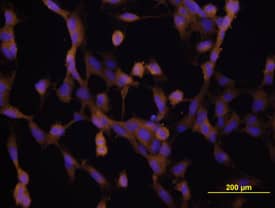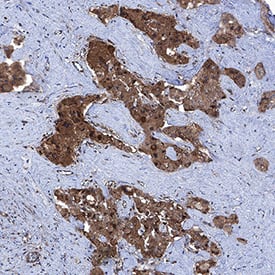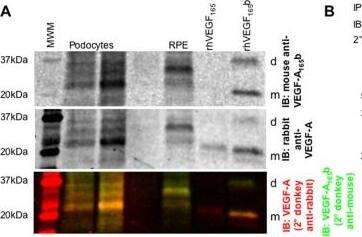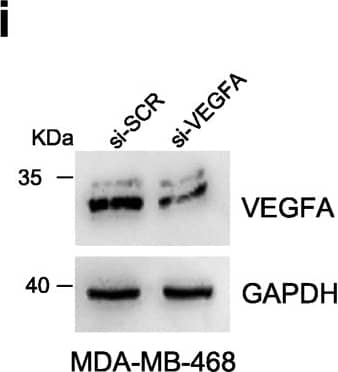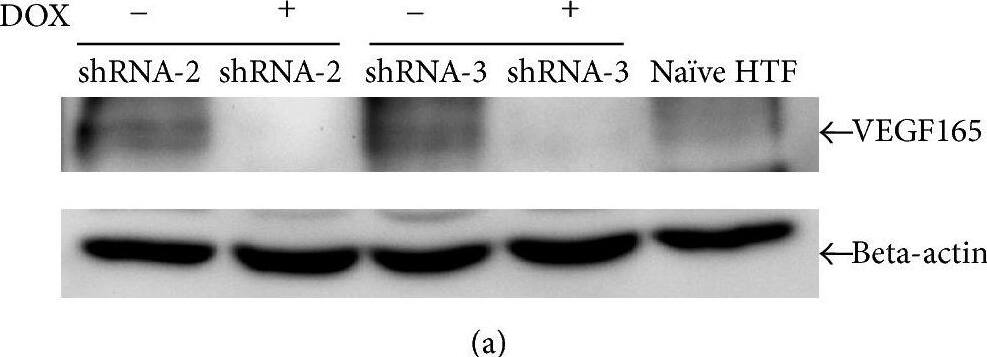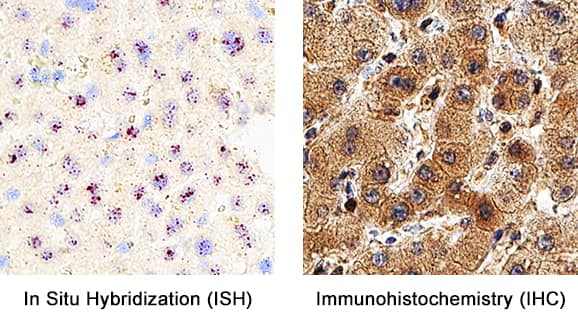Human VEGF165 Antibody
R&D Systems, part of Bio-Techne | Catalog # AF-293-NA

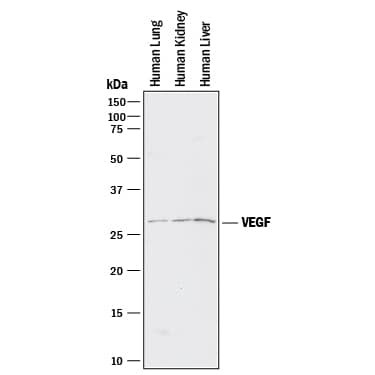
Key Product Details
Validated by
Biological Validation
Species Reactivity
Validated:
Human
Cited:
Human, Mouse, Rat, Porcine, Avian - Chicken, Avian - Quail, Bovine, Guinea Pig, Primate - Macaca mulatta (Rhesus Macaque), Rabbit
Applications
Validated:
Dual RNAscope ISH-IHC Compatible, Immunocytochemistry, Immunohistochemistry, Neutralization, Western Blot
Cited:
Affinity Assay, Bioassay, Column, ELISA, ELISA Capture, ELISA Development, ELISA Development (Capture), ELISA Development (Detection), Immunoassay Development, Immunocytochemistry, Immunohistochemistry, Immunohistochemistry-Frozen, Immunohistochemistry-Paraffin, Immunoprecipitation, Neutralization, Western Blot
Label
Unconjugated
Antibody Source
Polyclonal Goat IgG
Product Specifications
Immunogen
S. frugiperda insect ovarian cell line Sf 21-derived recombinant human VEGF165
Ala27-Arg191
Accession # NP_001165097.1
Ala27-Arg191
Accession # NP_001165097.1
Specificity
Detects human VEGF in direct ELISAs and Western blots.
Clonality
Polyclonal
Host
Goat
Isotype
IgG
Endotoxin Level
<0.10 EU per 1 μg of the antibody by the LAL method.
Scientific Data Images for Human VEGF165 Antibody
Detection of Human VEGF by Western Blot.
Western blot shows lysates of human lung tissue, human kidney tissue, and human liver tissue. PVDF membrane was probed with 5-10 µg/mL of Goat Anti-Human VEGF 165Antigen Affinity-purified Polyclonal Antibody (Catalog # AF-293-NA) followed by HRP-conjugated Anti-Goat IgG Secondary Antibody (HAF017). A specific band was detected for VEGF at approximately 27 kDa (as indicated). This experiment was conducted under reducing conditions and using Immunoblot Buffer Group 1.VEGF in HUVEC Cells.
VEGF was detected in immersion fixed human umbilical vein endothelial cells (HUVECs) using Goat Anti-Human VEGF165 Antigen Affinity-purified Polyclonal Antibody (Catalog # AF-293-NA) at 10 µg/mL for 3 hours at room temperature. Cells were stained using the NorthernLights™ 557-conjugated Anti-Goat IgG Secondary Antibody (yellow; NL001) and counter-stained with DAPI (blue). View our protocol for Fluorescent ICC Staining of Non-adherent Cells.VEGF in Human Liver Cancer Tissue.
VEGF was detected in immersion fixed paraffin-embedded sections of human liver cancer tissue using Goat Anti-Human VEGF165 Antigen Affinity-purified Polyclonal Antibody (Catalog # AF-293-NA) at 3 µg/mL for 1 hour at room temperature followed by incubation with the Anti-Goat IgG VisUCyte™ HRP Polymer Antibody (VC004). Before incubation with the primary antibody, tissue was subjected to heat-induced epitope retrieval using Antigen Retrieval Reagent-Basic (CTS013). Tissue was stained using DAB (brown) and counterstained with hematoxylin (blue). Specific staining was localized to cytoplasm in cancer cells. View our protocol for IHC Staining with VisUCyte HRP Polymer Detection Reagents.Applications for Human VEGF165 Antibody
Application
Recommended Usage
Dual RNAscope ISH-IHC Compatible
5-15 µg/mL
Sample: Immersion fixed paraffin-embedded sections of human liver
Sample: Immersion fixed paraffin-embedded sections of human liver
Immunocytochemistry
5-15 µg/mL
Sample: Immersion fixed human umbilical vein endothelial cells
Sample: Immersion fixed human umbilical vein endothelial cells
Immunohistochemistry
3-15 µg/mL
Sample: Immersion fixed paraffin-embedded sections of human liver cancer tissue
Sample: Immersion fixed paraffin-embedded sections of human liver cancer tissue
Western Blot
5-10 µg/mL
Sample: Human lung tissue, human kidney tissue, and human liver tissue
Sample: Human lung tissue, human kidney tissue, and human liver tissue
Neutralization
Measured by its ability to neutralize VEGF165-induced proliferation in HUVEC human umbilical vein endothelial cells. Conn, G. et al. (1990) Proc. Natl. Acad. Sci. USA 87:1323. The Neutralization Dose (ND50) is typically 0.02‑0.12 µg/mL in the presence of 10 ng/mL Recombinant Human VEGF165.
Reviewed Applications
Read 4 reviews rated 4.5 using AF-293-NA in the following applications:
Formulation, Preparation, and Storage
Purification
Antigen Affinity-purified
Reconstitution
Reconstitute at 0.2 mg/mL in sterile PBS. For liquid material, refer to CoA for concentration.
Formulation
Lyophilized from a 0.2 μm filtered solution in PBS with Trehalose. See Certificate of Analysis for details.
*Small pack size (-SP) is supplied either lyophilized or as a 0.2 µm filtered solution in PBS.
*Small pack size (-SP) is supplied either lyophilized or as a 0.2 µm filtered solution in PBS.
Shipping
Lyophilized product is shipped at ambient temperature. Liquid small pack size (-SP) is shipped with polar packs. Upon receipt, store immediately at the temperature recommended below.
Stability & Storage
Use a manual defrost freezer and avoid repeated freeze-thaw cycles.
- 12 months from date of receipt, -20 to -70 °C as supplied.
- 1 month, 2 to 8 °C under sterile conditions after reconstitution.
- 6 months, -20 to -70 °C under sterile conditions after reconstitution.
Background: VEGF
Long Name
Vascular Endothelial Growth Factor
Alternate Names
MVCD1, VAS, Vasculotropin, VEGF-A, VEGFA, VPF
Entrez Gene IDs
Gene Symbol
VEGFA
UniProt
Additional VEGF Products
Product Documents for Human VEGF165 Antibody
Product Specific Notices for Human VEGF165 Antibody
For research use only
